Tracy Miller Delivers Keynote Speech at Society for Architectural Historians–Taiwan
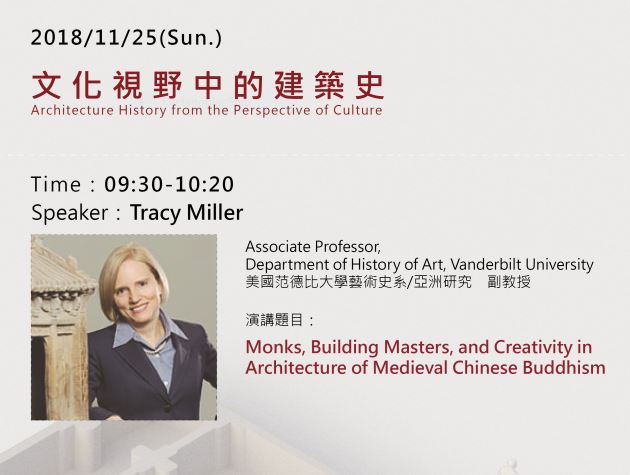 Tracy Miller, associate professor of history of art, delivered the keynote address at the Society for Architectural Historians–Taiwan on November 25 in Kaohsiung. Miller’s talk was entitled “Monks, Building Masters, and Creativity in the Architecture of Medieval Chinese Buddhism.”
Tracy Miller, associate professor of history of art, delivered the keynote address at the Society for Architectural Historians–Taiwan on November 25 in Kaohsiung. Miller’s talk was entitled “Monks, Building Masters, and Creativity in the Architecture of Medieval Chinese Buddhism.”
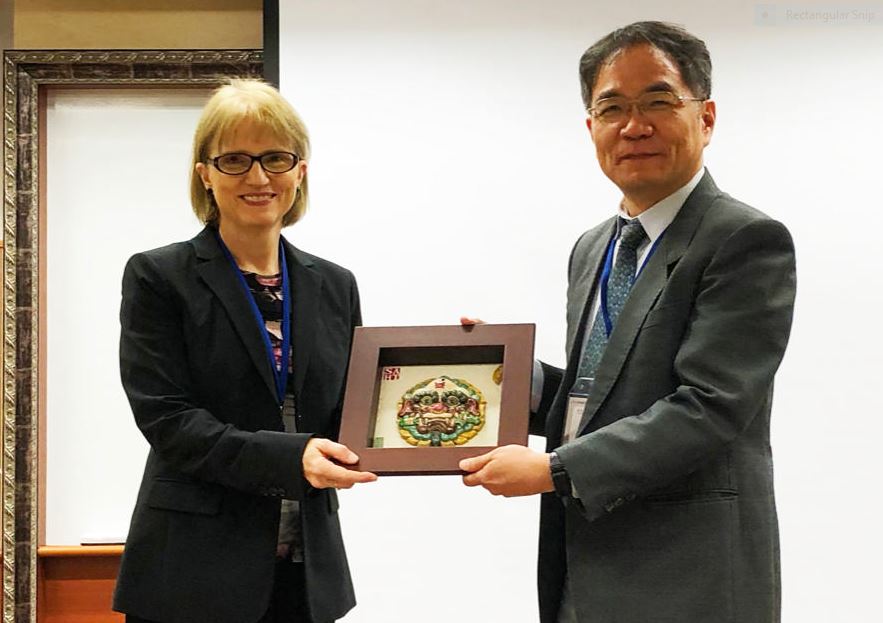 Shang-chia Chiou, president of the Society for Architectural Historians–Taiwan, presents Miller with a gift at the conference.
Shang-chia Chiou, president of the Society for Architectural Historians–Taiwan, presents Miller with a gift at the conference.
Posted by vrcvanderbilt on December 10, 2018 in Conferences, Events, HART, Lectures, News, Vanderbilt University, VRC
Sheri Shaneyfelt Lectures on Perugino’s Workshops in Florence and Perugia at Venice Conference
Sheri Shaneyfelt, principal senior lecturer in the history of art and the department’s director of undergraduate studies, presented a paper at the University of Warwick in Venice conference on November 27, which was held in the fifteenth-century Palazzo Pesaro-Papafava. Her talk was entitled “Renaissance Painting in Perugia: Pietro Perugino and the Italian Renaissance Workshop.”
In the year 1500, theSienese banker Agostino Chigi, writing from Rome to his father in Siena, described Pietro Perugino as “il meglio maestro d’Italia.” The classicizing solemnity, simple, formal beauty, and jewel-toned palette of his compositions were frequently imitated by his pupils, contemporaries, and followers. To meet rising demand, Perugino operated sizeable botteghe in both Florence and Perugia, from 1487 to 1511.
After considering the nature and composition of Perugino’s workshops, Shaneyfelt focused on the Società del 1496, a cooperative of five artists working in Perugia who capitalized on their ability to replicate Perugino’s manner, modeling compositional designs after the master. Their alliance, together with their interrelations among other local artists, is indicative of the community of collaboration inherent in the production of art in Renaissance Italy. Lastly, she introduced a group of pictures formulated after Perugino’s own, yet in the tondo format, which was far more common in Florence.
*Pietro Perugino, Pala dei Decemviri, tempera grassa on panel, 1495-1496, 193 x 165 cm, Vatican Pinacoteca.
Posted by vrcvanderbilt on December 5, 2018 in Conferences, Events, HART, Lectures, News, Vanderbilt University, VRC
Betsey Robinson Lectures on Ancient Landscapes at Hollins University Classics Symposium
Betsey Robinson, acting chair and associate professor of history of art, was an invited speaker at the annual Hollins University Classics Symposium in Roanoke, VA, on November 8. This year’s theme was “Being There–Martial and Mythological Landscapes of Greece.” Robinson’s lecture, entitled “Musing on Mountain Landscapes in Central Greece,” surveyed her ongoing work and recent discoveries on Greek mountains and their ancient sacred and mythological traditions, from Parnassos and Helikon to Arcadian Mount Chelmos and the marvelous waters of the Styx near the peak.
Robinson contrasted eyewitness accounts and imagined views as well as the interplays of religion and reputation in those ancient places. Her talk was paired with another, by Matt Sears of the University of New Brunswick, who focused on ancient battlefields and the experience—and importance—of visiting them, today as in 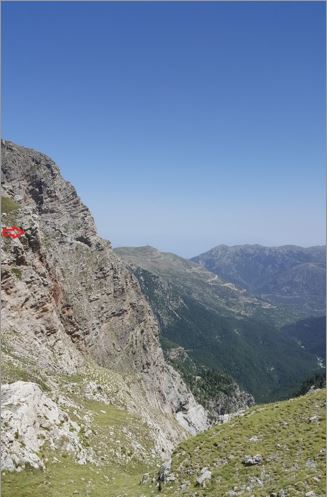 antiquity.
antiquity.
Mount Chelmos, ancient Arcadia, and the real water of the Styx (see arrow–just a trickle by early July).
“That cold water that drizzles down from a steep sky-climbing cliffside, and it is one horn of the Okeanos stream, and travels off that holy river a great course through night’s blackness under the wide-wayed earth and … this stream, greatly vexing the gods, runs off the precipice … the imperishable, primeval water of Styx…” Hesiod’s Theogony 775 (transl. Evelyn-White) [8th or 7th century BCE]
Early sunset, Sanctuary of Apollo at Delphi, on Mount Parnassos
Goats above the ancient theater in the Valley of the Muses, Mount Helikon, Central Greece
Posted by vrcvanderbilt on November 30, 2018 in Conferences, Events, HART, Lectures, News, Vanderbilt University, VRC
Maymester 2019: Exhibiting Art, Literature and Culture in Cuba
 Vivien Fryd, professor of history of art, and William Luis, professor of Spanish and director of Latino and Latina Studies, are offering a Maymester course entitled “Exhibiting Art, Literature and Culture in Cuba” (HART 3810/LATS 4961/5961) that will be held May 6 through May 31. This three credit hour course intersects with the 13th Havana Biennial in Matanzas, Cuba, whose artistic director is Maria Magdalena Campos-Pons, Cornelius Vanderbilt Chair of Fine Arts and professor of art. The Havana Biennial (April 12 to May 19) will focus on artists from Latin America, the Caribbean, Africa, Asia and the Middle East to underscore the international aspect of contemporary art. The class will study the work of international artists, including American artists, selected by Campos-Pons to be shown in her hometown of Matanzas as well as Cienfuegos and Havana.
Vivien Fryd, professor of history of art, and William Luis, professor of Spanish and director of Latino and Latina Studies, are offering a Maymester course entitled “Exhibiting Art, Literature and Culture in Cuba” (HART 3810/LATS 4961/5961) that will be held May 6 through May 31. This three credit hour course intersects with the 13th Havana Biennial in Matanzas, Cuba, whose artistic director is Maria Magdalena Campos-Pons, Cornelius Vanderbilt Chair of Fine Arts and professor of art. The Havana Biennial (April 12 to May 19) will focus on artists from Latin America, the Caribbean, Africa, Asia and the Middle East to underscore the international aspect of contemporary art. The class will study the work of international artists, including American artists, selected by Campos-Pons to be shown in her hometown of Matanzas as well as Cienfuegos and Havana.
Students will also study the history, religion, literature, and culture of Cuba, keeping in mind the traditions of art presses in Cuba that will result in the Symposium of Alternative Presses to be held concurrently with the Biennial. The class will focus on writers of the Cuban Revolution (primarily prose and poetry) and consider some of the Afro-Cuban religious manifestations typical of Cuban culture. In their travels to Havana, Matanzas, and Cienfuegos, students will tour these cities and their artistic projects and meet with artists, writers, religious practitioners, and other cultural promoters.
Course requirements include active participation and respectful engagement with the course both in class and on location. Students will keep a diary, interview one artist or writer, write one book review, and select a work of art at any of the venues and present a brief lecture to the class about that work.
The program is open to all Vanderbilt undergraduate and graduate students in good academic standing and with the consent of the instructors. Applications are due by January 31, 2019. For a complete itinerary and further information, email vivien.g.fryd@vanderbilt.edu or william.luis@vanderbilt.edu.
Posted by vrcvanderbilt on November 26, 2018 in HART, News, Student/Alumni, Vanderbilt University, VRC
Maymester Paris 2019: Modern French Art & Architecture in Paris
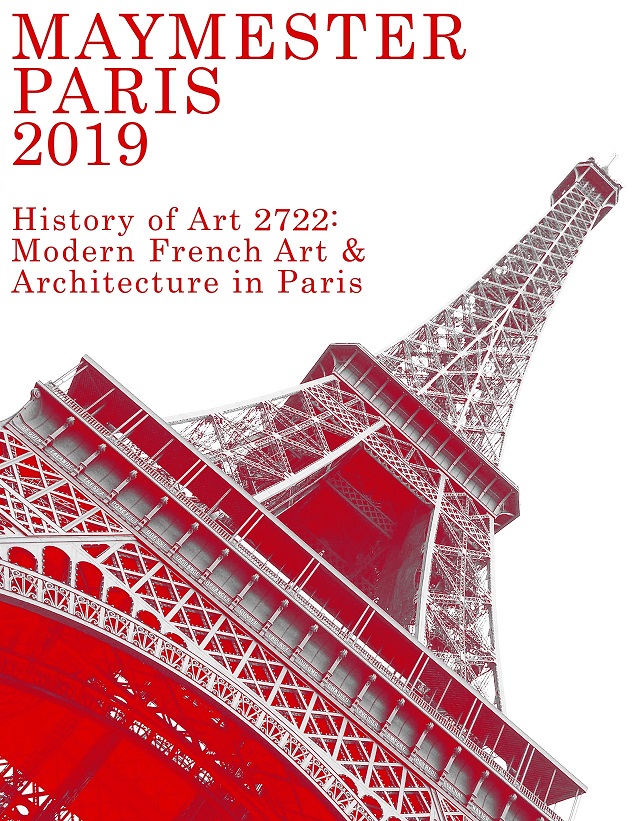 Leonard Folgarait, professor of art, is offering a Maymester 2019 course entitled Modern Art and Architecture in Paris (HART 2722) that will be held in the “City of Lights” from May 6-31. Paris was the center of western modern art movements throughout the 19th century until the mid-20th century. The major styles of painting, sculpture, architecture and various other media of this period were developed in this city, which became the exemplary modern city in western Europe and developed an extensive infrastructure of such cultural institutions as art academies, private galleries, and vast museums.
Leonard Folgarait, professor of art, is offering a Maymester 2019 course entitled Modern Art and Architecture in Paris (HART 2722) that will be held in the “City of Lights” from May 6-31. Paris was the center of western modern art movements throughout the 19th century until the mid-20th century. The major styles of painting, sculpture, architecture and various other media of this period were developed in this city, which became the exemplary modern city in western Europe and developed an extensive infrastructure of such cultural institutions as art academies, private galleries, and vast museums.
In the field of city planning, Paris led the development of urban modernization in western Europe in the second half of the 19th century with a vast reconstruction project that produced the central sections of Paris that we know today. The architecture of Paris in these two centuries has also set the standard for modernist styles, which includes the industrial aesthetic of both the Eiffel Tower and the Centre Pompidou, the gleaming glass pyramids of I.M. Pei’s design for the Louvre, and the stark minimalism of the National Library. Alongside such modernist examples one finds the opulent Paris Opera building and the dramatic redesign of the d’Orsay Train Station into the d’Orsay Museum.
Students will be immersed in an experience of studying art and architecture in Paris and will spend class periods touring sites in Paris, including the Eiffel Tower, the Musée d’Orsay, the Musée Picasso, two opera houses, a major department store, public parks, and the Centre Pompidou.
Instruction will be a combination of classroom lectures and intensive presentation and discussion of the art works and architecture in their presence. There will no traditional lectures, quizzes or exams, but rather an immersive experience in the actual viewing and analysis of artworks devoted to understanding how and why Paris has been such an important center of modern art. Students will write three 5-page interpretive papers on artworks or architecture located in Paris as exercises in first=hand analysis.
Applications are due by January 31, 2019. Interested applicants are encouraged to contact Leonard Folgarait with questions at: leonard.folgarait@vanderbilt.edu.
Posted by vrcvanderbilt on November 26, 2018 in HART, News, Student/Alumni, VRC
Rebecca VanDiver Awarded Dean’s Faculty Fellowship
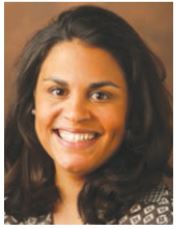 Rebecca VanDiver, assistant professor of African American art, has received a Dean’s Faculty Fellowship that was recently awarded by John Geer, dean of the College of Arts and Science. VanDiver, one of seven A&S tenure-track faculty members to be named a Dean’s Faculty Fellow, will hold the title for two years and receive additional support for her research.
Rebecca VanDiver, assistant professor of African American art, has received a Dean’s Faculty Fellowship that was recently awarded by John Geer, dean of the College of Arts and Science. VanDiver, one of seven A&S tenure-track faculty members to be named a Dean’s Faculty Fellow, will hold the title for two years and receive additional support for her research.
The Dean’s Faculty Fellows Program was launched this year to support untenured faculty in their research, scholarship, and creative expression during their probationary period. “These faculty were selected because of their scholarly accomplishments and the promise they show to make an impact in their respective fields,” said Dean Geer. “We look forward to continuing this program in the coming years as a way of providing additional support to our junior faculty and helping to advance their creativity and discovery.”
Named a 2018-2019 Faculty Fellow with the Robert Penn Warren Center for the Humanities, VanDiver is currently participating in a year-long interdisciplinary faculty seminar to explore the significance of printed words and images in early modern Europe and North America. She teaches courses on modern/contemporary African American and African art and visual culture.
Her research, centered on 20th-century black women artists, African American artistic engagements with Africa, and the politics of exhibition and display, has appeared in Archives of American Art Journal, Space and Culture, Callaloo, and Transition. Her book-length manuscript on Loïs Mailou Jones will be published by the Pennsylvania State University Press under the title Negotiating Traditions: Loïs Mailou Jones and the Composite Aesthetics of Blackness.
Posted by vrcvanderbilt on November 16, 2018 in HART, News, Vanderbilt University, VRC
Matthew Worsnick to Present Paper at Conference Held in Rome November 15-16
Matthew Worsnick, assistant professor of the practice of art history, will present his paper, “Excavating the Contested Adriatic Borderlands: Historiography and Preservation in Fascist Italy and Communist Yugoslavia,” on November 16 at a two-day 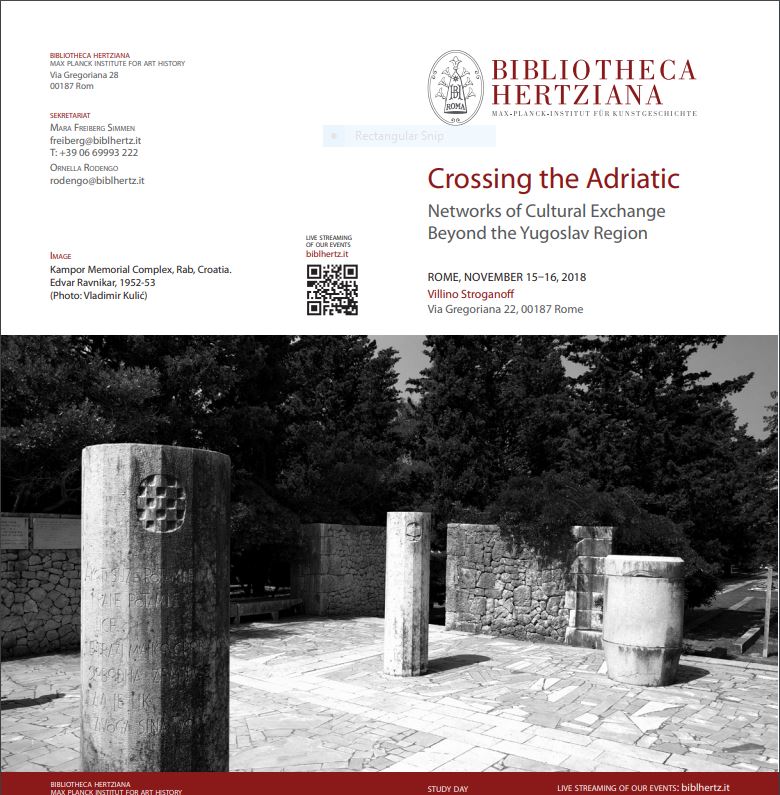 conference held in Rome at the Villino Stroganoff and hosted by the Bibliotheca Hertziana–Max Planck Institute for Art History. “Crossing the Adriatic: Networks of Cultural Exchange Beyond the Yugoslav Region” is the overall theme of the program.
conference held in Rome at the Villino Stroganoff and hosted by the Bibliotheca Hertziana–Max Planck Institute for Art History. “Crossing the Adriatic: Networks of Cultural Exchange Beyond the Yugoslav Region” is the overall theme of the program.
Organized within the framework of the exhibition “Toward a Concrete Utopia: Architecture in Yugoslavia, 1948-1980” on view through January 19 at the Museum of Modern Art in New York City, the “study day” on November 16, convened by co-curators Martino Stierli and Vladimir Kulić with curatorial assistant Anna Kats and Tristan Weddigen, director of the Biblioteca Hertziana, will not be limited solely to architecture. Worsnick and other participants will also look at networks of cultural production and exchange more broadly along the Adriatic coasts.
Posted by vrcvanderbilt on November 15, 2018 in Conferences, Events, HART, Lectures, News, Vanderbilt University, VRC
Lillian Boyle Reflects on Highlights of Class Field Trip to New York City
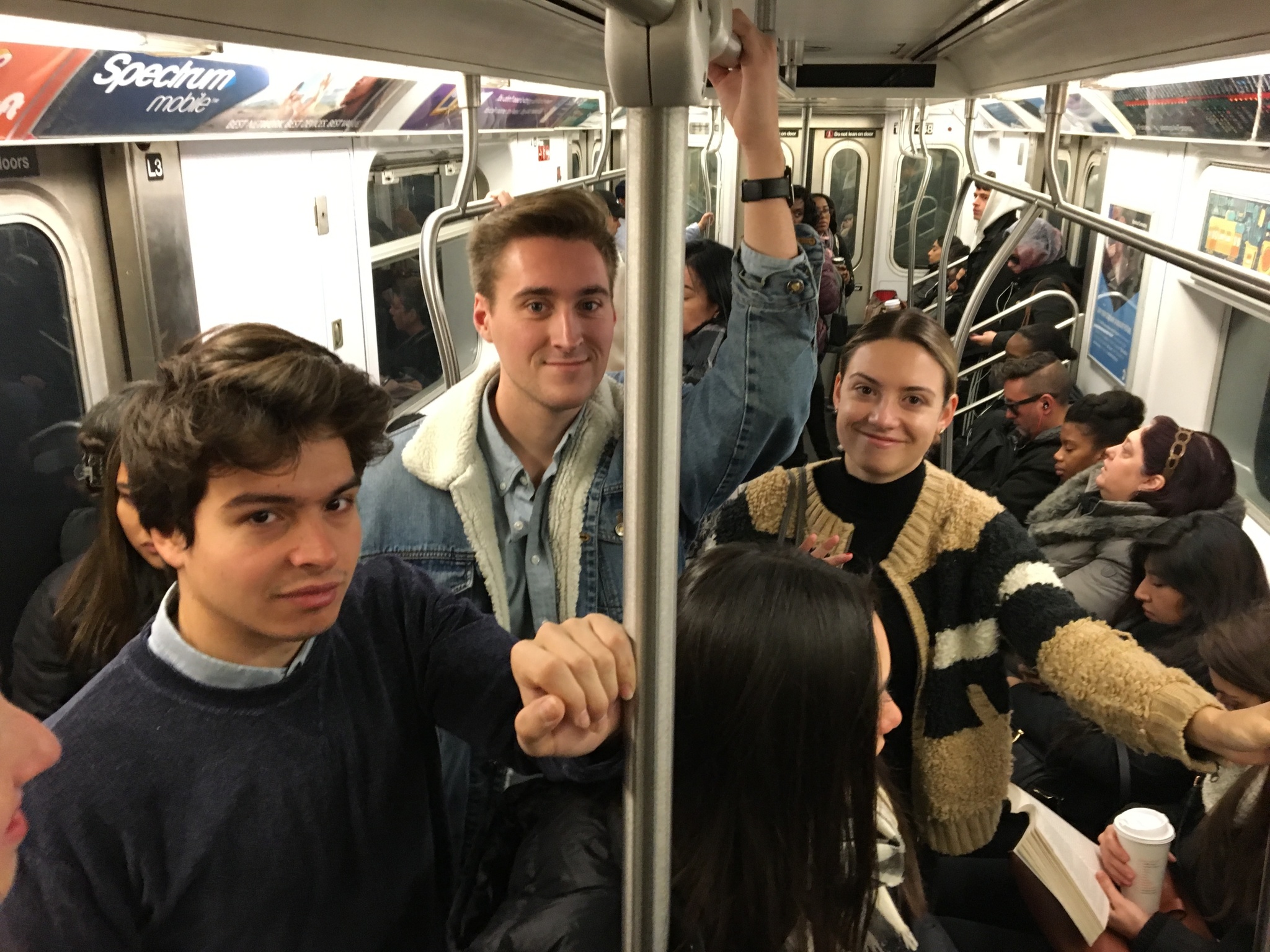 In an action-packed three days (October 25-27), my curation seminar class (Exhibiting Historical Art: Architecture at MoMA) traversed New York City from Columbia University on the Upper West Side to the Museum of Modern Art in Midtown and all the way downtown to Greenwich Village to attend a symposium at the Remarque Institute, New York University. The symposium featured experts speaking on Yugoslav history and architecture, including two Vanderbilt University professors, Matthew Worsnick, assistant professor of the practice of art history, and Emily Greble, associate professor of history. The panel also included Svetlana Broz, political activist and granddaughter of the Yugoslav leader Josip Broz Tito.
In an action-packed three days (October 25-27), my curation seminar class (Exhibiting Historical Art: Architecture at MoMA) traversed New York City from Columbia University on the Upper West Side to the Museum of Modern Art in Midtown and all the way downtown to Greenwich Village to attend a symposium at the Remarque Institute, New York University. The symposium featured experts speaking on Yugoslav history and architecture, including two Vanderbilt University professors, Matthew Worsnick, assistant professor of the practice of art history, and Emily Greble, associate professor of history. The panel also included Svetlana Broz, political activist and granddaughter of the Yugoslav leader Josip Broz Tito.
 Highlights of our trip included visits to the archives of the Avery Architectural and Fine Arts Library at Columbia University as well as to MoMA’s groundbreaking exhibit, “Toward a Concrete Utopia: Architecture in Yugoslavia, 1948-1980.”
Highlights of our trip included visits to the archives of the Avery Architectural and Fine Arts Library at Columbia University as well as to MoMA’s groundbreaking exhibit, “Toward a Concrete Utopia: Architecture in Yugoslavia, 1948-1980.”
Jennifer Gray, chief curator of drawings and archives at Avery, led the class through selections from the library’s extensive archives of the legendary American architect Frank Lloyd Wright. Gray discussed the curatorial choices she made that shaped MoMA’s exhibit “Frank Lloyd Wright at 150: Unpacking the Archive,” which she co-curated with historian Barry Bergdoll. This major retrospective, a celebration of the 150th anniversary of the architect’s birth, examined his drawings and models from a variety of critical perspectives. In keeping with the exhibition’s title, Gray “unpacked” the Avery archives for the class and brought the Frank Lloyd Wright exhibit to life again for those who did not see the exhibit during its run in 2017.
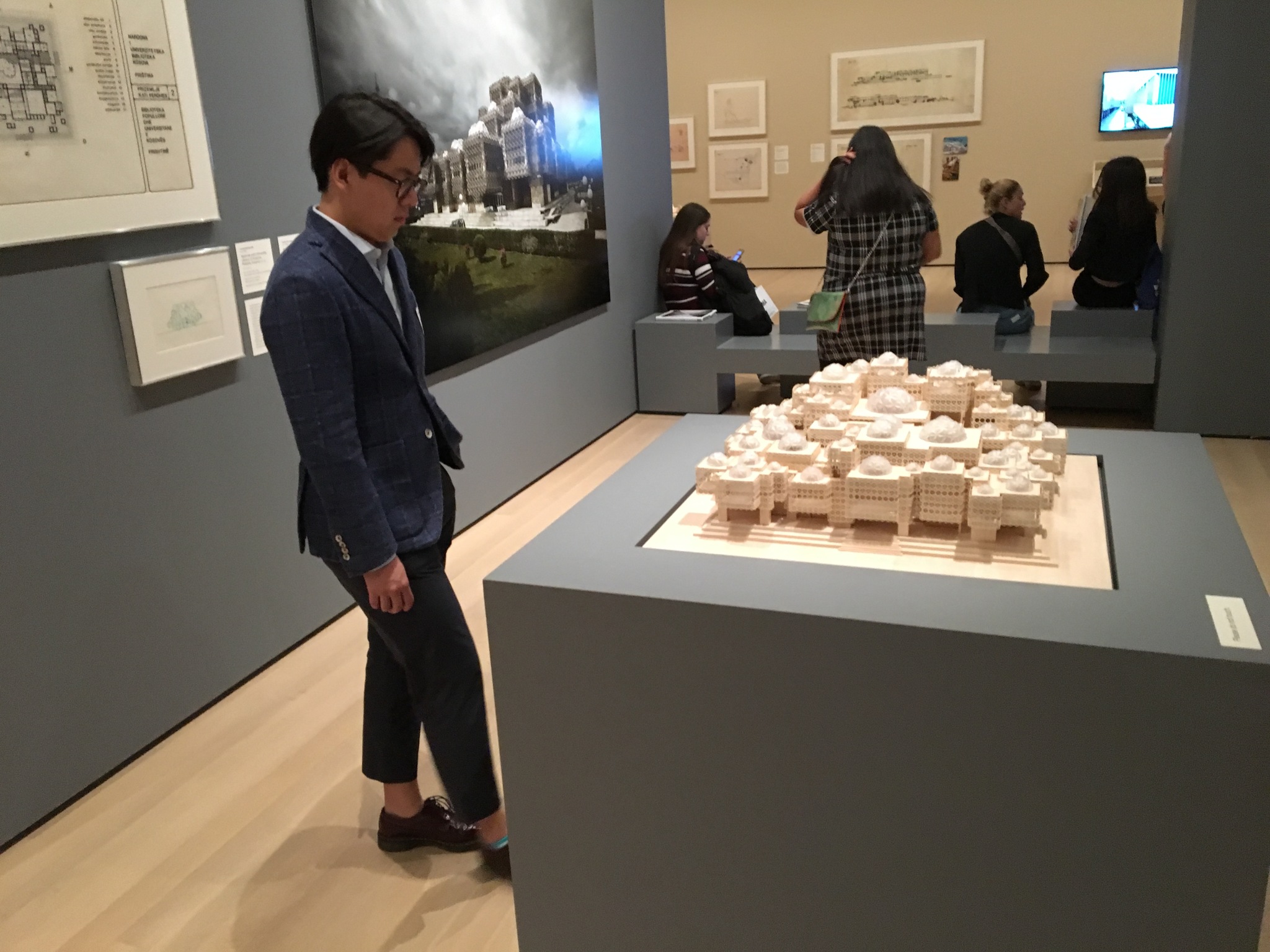 After spending the greater part of the semester studying Yugoslav history, architecture and the exhibition itself, we were all eager to experience “Toward a Concrete Utopia” firsthand—initially with Professor Worsnick, who had worked on the exhibit and contributed essays to the companion volume. The exhibit introduces the viewer to Yugoslavia’s modernist tradition, showcasing the often-daring forms and innovative designs of its architects from 1948 to 1980, including Bogdan Bogdanović, Juraj Neidhardt, Svetlana Kana Radević, Edvard Ravnikar, Vjenceslav Richter, and Milica Šterić, among others. It focuses on the period of intense construction in the former Yugoslavia from its break with the Soviet bloc in 1948 to the death of the country’s longtime leader Josip Broz Tito in 1980. The works on display—around 400 drawings, models, photographs, and film reels—are drawn from an array of more than 50 municipal archives, private collections, and museum holdings in the region and across Europe and the United States.
After spending the greater part of the semester studying Yugoslav history, architecture and the exhibition itself, we were all eager to experience “Toward a Concrete Utopia” firsthand—initially with Professor Worsnick, who had worked on the exhibit and contributed essays to the companion volume. The exhibit introduces the viewer to Yugoslavia’s modernist tradition, showcasing the often-daring forms and innovative designs of its architects from 1948 to 1980, including Bogdan Bogdanović, Juraj Neidhardt, Svetlana Kana Radević, Edvard Ravnikar, Vjenceslav Richter, and Milica Šterić, among others. It focuses on the period of intense construction in the former Yugoslavia from its break with the Soviet bloc in 1948 to the death of the country’s longtime leader Josip Broz Tito in 1980. The works on display—around 400 drawings, models, photographs, and film reels—are drawn from an array of more than 50 municipal archives, private collections, and museum holdings in the region and across Europe and the United States.
On a second visit to MoMA, Mack Cole-Edelsack, architect and senior design manager in the department of exhibition design, offered the class another perspective on the exhibit, namely its exceptional design. Organized thematically, the galleries are divided into four broad categories or sections: modernization, global networks, everyday life, and identities. Original drawings and models are interspersed with Swiss photographer Valentin Jeck’s contemporary photographs of some of the most iconic buildings and monuments of the historically multiethnic region. Video installations by the filmmaker Mila Turajlić, drawn from documentary footage, newsreels, feature films, and TV shows, introduce some of 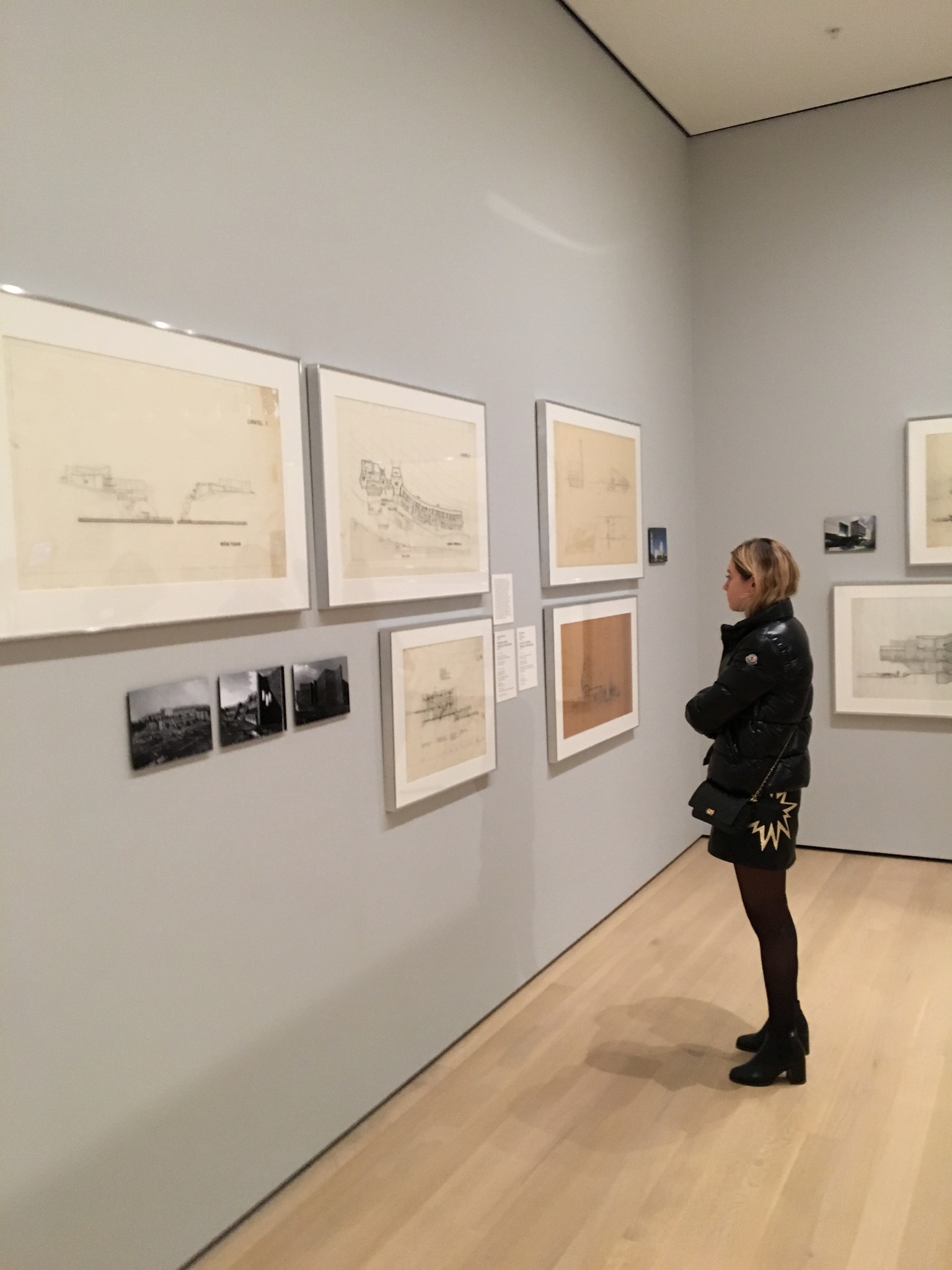 the themes that structure the show, such as large-scale urbanization, design for everyday life, the global reach of Yugoslav architecture, and the reconstruction of the city of Skopje after the devastating 1963 earthquake, among others.
the themes that structure the show, such as large-scale urbanization, design for everyday life, the global reach of Yugoslav architecture, and the reconstruction of the city of Skopje after the devastating 1963 earthquake, among others.
Our time at the Museum of Modern Art that day ended on a high note with a roundtable discussion with Vladimir Kulić, co-curator of the “Toward a Concrete Utopia” exhibit, Svetlana Broz, and the MoMA Mellon MRC Fellows. I had the opportunity to ask Svetlana Broz about her experience as a woman and the feminist movement in Yugoslavia. Her insightful response enhanced my understanding of the female experience in her country, greatly contributing to my final paper on female architects in socialist Yugoslavia.
We spent our morning on Museum Row at New York University’s Institute of Fine Arts where the class discussed curatorial strategy with Jean-Louis Cohen, esteemed architectural scholar and curator of many exhibitions, including “Le Corbusier: An  Atlas of Modern Landscapes” at the Museum of Modern Art in 2013. Our discussion provided the perfect ending for our ongoing conversations throughout the weekend about curatorial decision making, theory, and practice. In addition, Professor Worsnick led an architectural tour of the James B. Duke mansion, a historic landmark that is now home to the Institute. Afterwards, in the time remaining, we split up to visit the museum of our choice before heading to the airport.
Atlas of Modern Landscapes” at the Museum of Modern Art in 2013. Our discussion provided the perfect ending for our ongoing conversations throughout the weekend about curatorial decision making, theory, and practice. In addition, Professor Worsnick led an architectural tour of the James B. Duke mansion, a historic landmark that is now home to the Institute. Afterwards, in the time remaining, we split up to visit the museum of our choice before heading to the airport.
This wonderful weekend profoundly inspired my fellow students and me to continue our study of the history of art, pursue graduate degrees, and explore careers in curation. Thank you to Professors Matthew Worsnick, Betsey Robinson, and Kevin Murphy, and Julia Kamasz and the History of Art department for making the class trip possible!—Lillian Boyle
*Photographs courtesy of Matthew Worsnick
Posted by vrcvanderbilt on November 13, 2018 in Events, HART, News, Student/Alumni, Vanderbilt University, VRC
Matthew Worsnick Leads Curation Seminar Trip to New York City October 25-27
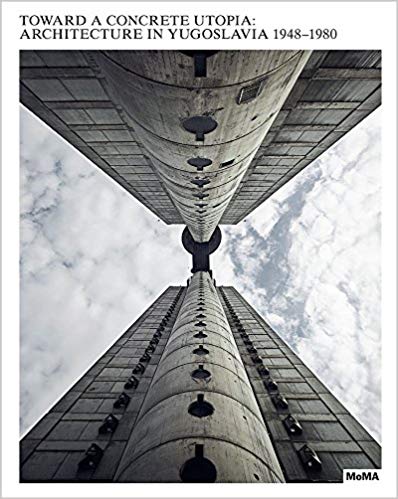 From the sculptural interior of the White Mosque in rural Bosnia, to the post-earthquake reconstruction of the city of Skopje based on Kenzo Tange’s Metabolist design, to the new town of New Belgrade, with its expressive large-scale housing blocks and civic buildings, the exhibition examines the unique range of forms and modes of production in Yugoslav architecture and its distinct yet multifaceted character. (The Museum of Modern Art’s “Toward a Concrete Utopia: Architecture in Yugoslavia, 1948-1980”)
From the sculptural interior of the White Mosque in rural Bosnia, to the post-earthquake reconstruction of the city of Skopje based on Kenzo Tange’s Metabolist design, to the new town of New Belgrade, with its expressive large-scale housing blocks and civic buildings, the exhibition examines the unique range of forms and modes of production in Yugoslav architecture and its distinct yet multifaceted character. (The Museum of Modern Art’s “Toward a Concrete Utopia: Architecture in Yugoslavia, 1948-1980”)
Matthew Worsnick, assistant professor of the practice of art history, and students in his advanced seminar and exhibit course, “Exhibiting Historical Art: Architecture at MoMA,” recently returned from New York City where they viewed MoMA’s exceptionally designed show, “Toward a Concrete Utopia: Architecture in Yugoslavia, 1948-1980,” and met with members of the curatorial team. In their seminar the students are investigating both the curation of the exhibition and its subject matter, which Worsnick describes as “the philosophically intricate, sometimes surreal, often spectacular architecture produced by the communist state of Yugoslavia during the Cold War.” As a Mellon Foundation Fellow in MoMA’s Department of Architecture and Design, Worsnick worked on the exhibition and contributed to a companion volume published to coincide with the exhibition.
Read more about the class trip in a blog post contributed by Lillian Boyle, a Vanderbilt graduate student pursuing a masters degree in the department of history of art.
Posted by vrcvanderbilt on November 13, 2018 in Events, HART, News, Student/Alumni, Vanderbilt University, VRC
Vanderbilt’s ‘Art, Democracy and Justice’ Lecture Series to Open at the Frist on November 14
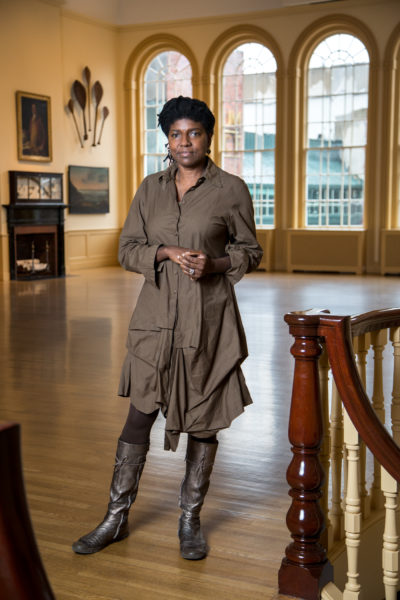 Maria Magdalena Campos-Pons, the Cornelius Vanderbilt Chair of Fine Arts and professor of art, will launch the lecture series “Art, Democracy and Justice” with three prominent artistic voices at the Frist Art Museum on Wednesday, November 14. The event, free and open to the public, will begin at 6:00 pm in the Frist Auditorium.
Maria Magdalena Campos-Pons, the Cornelius Vanderbilt Chair of Fine Arts and professor of art, will launch the lecture series “Art, Democracy and Justice” with three prominent artistic voices at the Frist Art Museum on Wednesday, November 14. The event, free and open to the public, will begin at 6:00 pm in the Frist Auditorium.
“This is a deeply important time in our nation’s history for these conversations on the integral relationships between art, democracy and justice,” said Campos-Pons. “Art does not happen in a vacuum. Art mirrors society, and is a testimony to our time.”
Campos-Pons, whose own work investigates themes of history, memory, gender and religion and how they inform identity, wants to connect the Department of Art and Vanderbilt, more broadly, to a growing dialogue around the world about what is shifting in the practice of art and democracy.
“I’m particularly excited for our visiting speakers to add to the expanding reach and rigor of our department’s curriculum,” Campos-Pons said. Joining her for the inaugural event are:
Holland Cotter, co-chief art critic and a senior writer at The New York Times; His numerous awards include the Pulitzer Prize for Criticism and the Lifetime Achievement Award for Art Writing from the College Art Association. Cotter, a former contributing editor to Art in America, earned a master of philosophy in South Asian art from Columbia University.
Olu Oguibe, Nigerian-born artist and writer; His work has been exhibited in museums and galleries around the world, and he is a senior fellow of the Smithsonian Institution. He received the 2017 Arnold Bode Prize of the City of Kassel for Documenta14.
Adam Szymczk, Polish artist who was artistic director of Documenta14 (Athens/Kassel). He co-founded the Foksal Gallery in Warsaw and served as director of Kunsthalle Basel, a place for innovative contemporary art exhibitions of an emerging generation of artists. He is a recipient of the Walter Hopps Award for Curatorial Achievement from the Menil Foundation.
“Our panelists are current thinkers and makers who will bring their fresh perspectives to the role of art as a social and cultural shaper,” said Campos-Pons. “And having an artist, administrator and critic engage face-to-face on our topic could provide some interesting dynamics. I’m also excited for the expertise of our visiting speakers to add to the expanding reach and rigor of the curriculum of Vanderbilt’s Department of Art.”
Campos-Pons, who joined the faculty in 2017, said she is pleased to have the Frist Art Museum and Fisk University as partners, as her department wants to develop more synergy with community organizations and institutions on art-related issues of broad public and academic interest.
This event is also made possible with collaboration and generous support from Vanderbilt’s Department of Art, Office of the Chancellor, and Dean’s Office of the College of Arts and Science.—Ann Marie Deer Owens (MyVU: Vanderbilt News, November 10, 2018)
*Photo of Maria Magdalena Campos-Pons courtesy of Peabody Essex Museum
Posted by vrcvanderbilt on November 12, 2018 in Events, HART, HART in Nashville, Lectures, News, Student/Alumni, Vanderbilt University, VRC


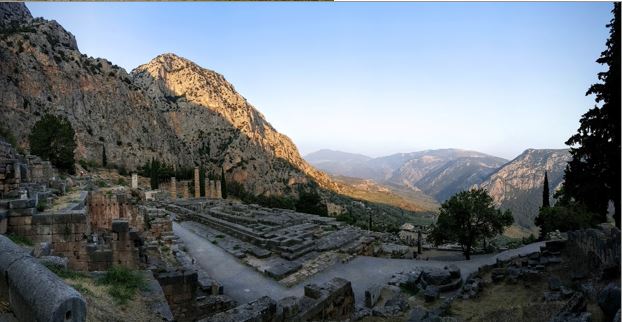
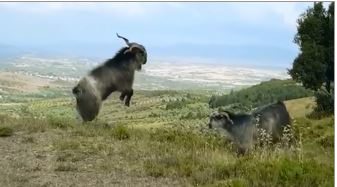
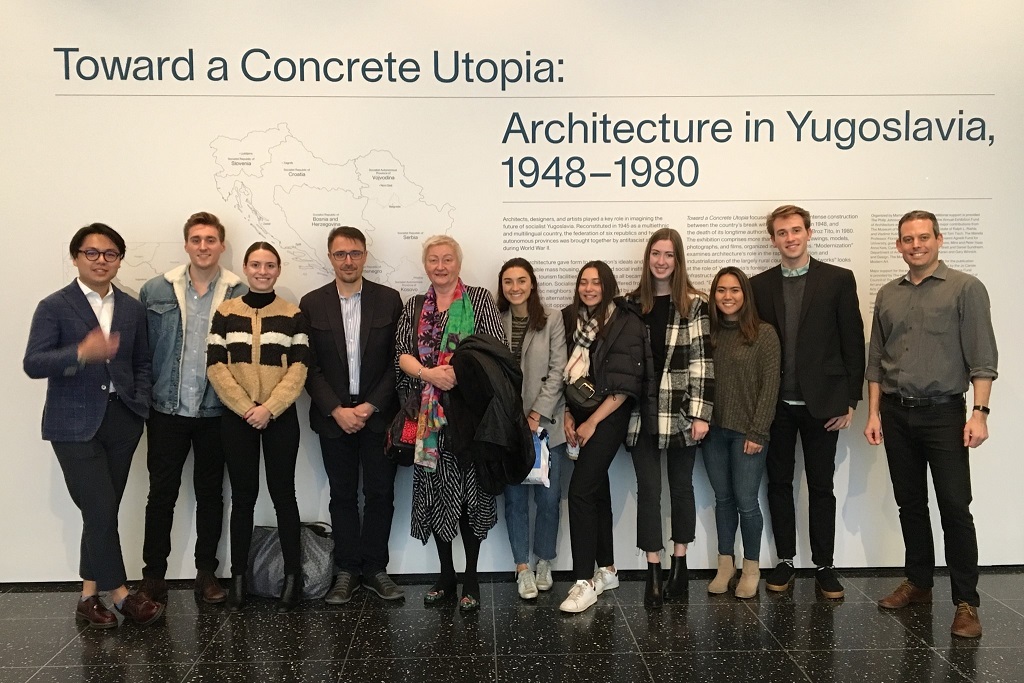
©2025 Vanderbilt University ·
Site Development: University Web Communications